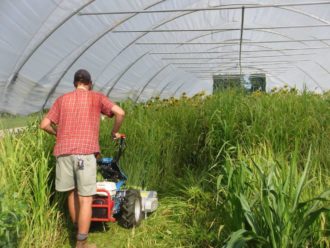Soil Management in Using Cover Crops in High Tunnels.pdf 1.01 MB
Introduction
Cover cropping involves growing, but not harvesting, an annual grass, legume or a mixture of grass and legume species. Cover crops can be used to satisfy National Organic Program requirements falling under the soil fertility and crop nutrient management and crop rotation practice standards. Cover crops benefit cropping systems through:
- Building soil organic matter
- Improving soil physical properties
- Reducing soil erosion
- Retaining mineral nutrients
- Increasing nitrogen fertility
- Conserving soil moisture
- Suppressing weeds and pests
In southern climates, high tunnels are typically used for season extension in the spring, fall, and winter. In the hot summer months, if no shade cloth is used to cover high tunnels, it can be difficult to grow anything but the most heat tolerant crops, and it can be uncomfortable to work in tunnels due to the heat. This is an excellent time to incorporate a cover crop, between the late spring and early fall crops. Many cover crops species are adapted to hot southern summers and perform well in high tunnels.
Soil Management
Two of the main challenges to production in high tunnels are managing soil-borne pests and nutrients over time. Pathogen and fertility issues can develop quickly due to the semi-closed environment and difficulty rotating crops within limited space. Once soil-borne pathogens are established in a high tunnel, it is difficult to manage them organically and serious infestations can make a high tunnel unusable. As fertilizers are continuously added in high tunnels, any mineral nutrients that are not taken up by cash crops are not leached out of the system by rains, leading to elevated pH and increased salt levels in the soil.
Cover crops are an excellent management tool for addressing both issues. Cover crops can help break pathogen lifecycles, and Brassica cover crops can be used for their biofumigant action in soil to help manage soil-borne pathogens.
Cover crops are an excellent source of mineral nutrients. A simple method for estimating nitrogen from cover crops can be found in Managing Cover Crops Profitably. Based on this estimation and soil test results, fertilizers (compost, manure and other organic fertilizers) can be accurately applied in an organic high tunnel production system. Additionally, cover crops such as sunflowers, mustard, and millet/cowpeas, can be utilized to remove excess salts from soil due to the plant’s ability to accumulate high levels of salts (Bhatt and Indirakutty, 1973).
Establishment
Growers commonly broadcast cover crop seeds, since most seed drills do not fit in high tunnels. The soil must be prepared well so it is easy to work the seeds into the soil. It is recommended to roll/press, rake, or lightly till the seeds into the soil to ensure good germination and avoid predation by birds.
Irrigation
It is necessary to use overhead irrigation to get a good stand when growing cover crops in high tunnels. Low cost options (~$110/tunnel), such as mini-wobbler sprinkler heads, are available. They can be temporarily installed and removed using poly irrigation tubing on ground level or installed permanently above the high tunnel trusses using PVC pipes.
The location of sprinkler heads is determined by crop type and duration. Taller grass cover crops may require installing overhead irrigation to the high tunnel frame in order to ensure uniform distribution of water.
Termination
Growers should decide how to terminate a cover crop before planting. There are many methods for terminating open field cover crops, but large field equipment often does not fit inside high tunnels. You can mow cover crops with a flail mower, rotary cutter or string trimmer, or you can use a crimper to bend and snap the crops. Once terminated, you must decide whether to incorporate the biomass by tilling or leave it as a mulch for the next crop. In the case of removing salts, cover crops should be harvested and not be incorporated into soil.
Conclusion
Although cover crops might not have short-term financial reward, their long-term economic benefits to farms are seen through reduced cost of fertilizer and pest control, and improved yields through better quality soil. To get the full benefits of cover crops, planting the right cover crop species at the right time is very important to the long-term viability of high tunnels.
This product was developed with support from the Southern Sustainable Agriculture Research and Education (Southern SARE) program, which is funded by the U.S. Department of Agriculture—National Institute of Food and Agriculture (USDA-NIFA). Any opinions, findings, conclusions or recommendations expressed within do not necessarily reflect the view of the Southern SARE program or the U.S. Department of Agriculture. USDA is an equal opportunity provider and employer.
